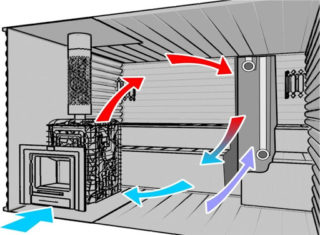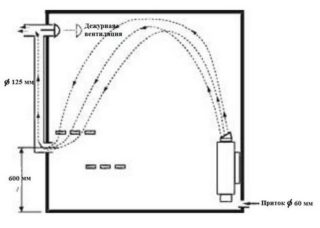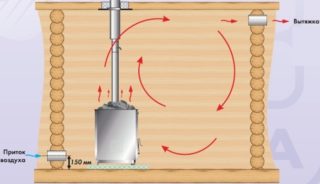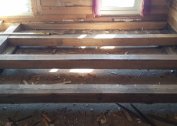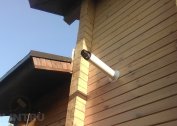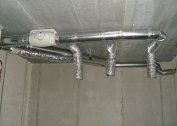Russian bath is intended not only for washing and taking hygienic procedures. At the same time, this is a place to relax with the whole family and meeting with friends. Therefore, the design of the bathhouse is carefully thought out even at the stage of its design. Particular attention is paid to properly organized ventilation of internal spaces.
Features of air exchange in the bath
When choosing a ventilation scheme in a bathhouse, the material from which it is made is of decisive importance. In addition, the location of the bathhouse is taken into account (it is separate from or adjacent to the main building). One of the common methods of ventilating a steam room is volley airing, when doors and windows open for a short time. In addition, for general ventilation of the bath spaces are used:
- specially prepared products in the foundation;
- additional holes in the wall or ceiling;
- door clearances.
Using windows in the steam room is a good solution, which is not always possible to implement due to their absence. The same can be said about the vents in the foundation, which cannot be arranged with a bathhouse, which is part of a residential building. In such situations, it will be necessary to choose a more suitable ventilation option.
Description and features of ventilation bastu
The name bastu ventilation got its name from the Swedish “bastu” or sauna. The basis of its action is a combined scheme that provides air renewal in the following places:
- in the upper part of the room - due to the formation of a closed air circuit;
- in the middle of the bath space, where heated ascending and descending cooled air masses are found;
- in the lower zone - by organizing the supply and exhaust system.
Thanks to the special principle of flow organization, warm masses accumulate under the steam room ceiling, forming a kind of inverted dome. The decisive condition for its receipt is the complete tightness of the room, in which drafts are unacceptable. Only in this case the air in the steam room is effectively heated with a minimum of energy costs.
The top hood in the basta bath is not used at all, which is the main condition for the normal functioning of ventilation. The lower exhaust vents are designed in the form of two pipes equipped with standard valves. They are recommended to be mounted as far as possible from each other - on opposite walls of the structure, for example.
The bastu ventilation scheme in the bath allows opening vents as needed. At the same time, it is taken into account that the system is operable only in situations when the furnace is already ignited or a strong wind is outside. These conditions ensure that fresh air is drawn in for good traction. When new air masses appear in the bathhouse or sauna, the already used ones are discharged through the pipe located above.
Advantages and disadvantages
The main advantage of the bastu system is the simplicity of its arrangement and the minimum cost. In addition, due to the continuous circulation, the air in the bath warms up more evenly, the objects inside it also warm up more efficiently. The advantages of this principle of air exchange also include:
- fresh air from the street;
- there is no need to equip forced ventilation;
- care of the bath is greatly simplified.
The disadvantages of the bastu ventilation system are manifested in different ways and depend on the specific situation.With wood stoves, entering the steam room is allowed only after complete combustion of the fuel. During this time, due to the supply channel, the room cools down, which forces it to resort to an additional firebox.
DIY installation rules for bastu ventilation in the bathhouse
Do-it-yourself ventilation of the bastu in the bathhouse is equipped only after preparatory measures:
- elaboration of the layout of the outlet pipes and ventilation hatches with valves;
- preparation of necessary tools for work;
- procurement of basic materials and components.
When preparing the layout of the wiring of the branch and intake channels, the size and type of premises must be taken into account. For each of them, their own duct sizes are provided.
To install ventilation for a bath, a bastu needs a standard set of tools, including an electric jigsaw, a drill and marking tools. From materials, it will be necessary to purchase pieces of steel or plastic pipes of appropriate length and diameter. In addition, it is necessary to stock up with valves of the appropriate size and shape, as well as protective grilles.
With a step-by-step procedure for installing ventilation bastu, anyone can read the instructions for installing the system:
- In the lower part of the room, two identical holes are prepared in which previously prepared pipe sections are placed.
- Outside, protective grilles are mounted on them, and sashes with gate valves are installed inside.
- The system is checked for performance.
A typical mistake made when arranging ventilation is the incorrect arrangement of pipes, which should be removed as far as possible from one another. Another erroneous action is the incorrectly selected diameter of the intake pipes.
Ways to increase ventilation power
The ventilation power of this type can be increased in simple ways. With the internal location of the ash pan, the steam room oven is surrounded by a slight elevation. At the same time, the air closest to it will warm up faster, which will increase the speed of its circulation and the ventilation efficiency. If the ash pan is located in the relaxation room, the closed part of the furnace is usually shifted to the steam room.
Under the steam room floor, it is possible to arrange an additional pipe that exhausts the exhaust air. Next, the opposite end of this exhaust duct is brought under the ash pan. This technique will allow you to remove air from the room faster than the hood in the steam room does. If it is not possible to increase the efficiency, the exhaust duct is in any case left as additional ventilation.
